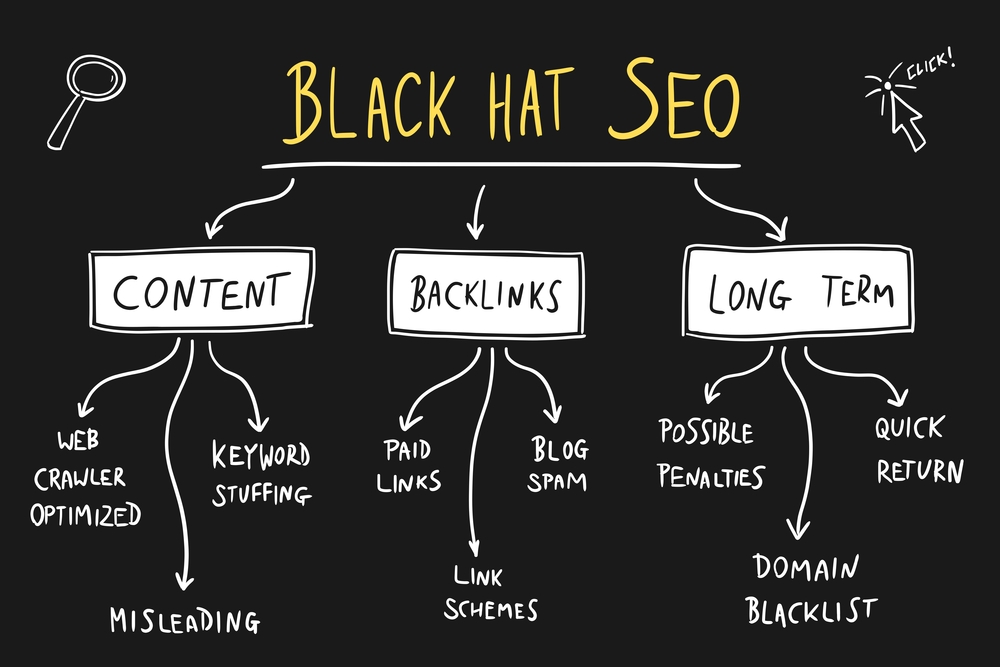The Battle: Black Hat vs White Hat SEO
In the digital battleground of Search Engine Optimization (SEO), two factions stand in stark contrast, battling for supremacy in search engine rankings – the Black Hats and the White Hats. Like in an old Western movie, these designations aren’t just mere labels; they symbolize two profoundly different philosophies, tactics, and potential outcomes. This article is your ringside ticket to the clash of the SEO titans: Black Hat vs White Hat SEO.
In the coming sections, we’ll delve into the intricate mechanics of both strategies, exploring their pros, cons, and repercussions. We will demystify the often blurry grey areas separating these two, helping you choose the right path to scale the steep slopes of SEO rankings. Brace yourself for a thrilling ride into the heart of search engine manipulation, optimization, and the ethical dilemmas encountered on the way. Buckle up, as we venture into the wild wild web!
What’s the difference: Black Hat vs White Hat SEO?
Unmasking the SEO Showdown: Black Hat vs White Hat SEO – we dive into the crucial differences, assessing the tactics, ethics, and risks associated with each strategy to help you navigate the dynamic landscape of search engine optimization.
The key difference between Black Hat and White Hat SEO is how they comply with search engine guidelines.
White Hat SEO involves techniques that are fully in line with the terms and conditions of major search engines, including Google. The focus is on providing value for users with a more holistic approach. This includes high-quality content, well-labelled images, relevant links and references, complete sentences with good spelling and grammar, standard-compliant HTML, and unique and relevant page titles.
On the other hand, Black Hat SEO uses tactics that are designed to trick search engines and violate their rules in order to achieve higher rankings quickly. These techniques include keyword stuffing, invisible text, doorway pages, adding unrelated keywords to the page content or in meta tags, and more. These tactics can lead to penalties, or even being completely removed from search results.
While Black Hat may bring quick results, in the long run, it is risky and not sustainable. White Hat SEO, although it takes more time and effort, ensures a steady and lasting growth in search rankings.
What about Grey Hat SEO?
Dancing on the Edge: Grey Hat SEO, a blend of strategies meshing both the ethical White Hat tactics and the riskier, rule-bending manoeuvres of Black Hat SEO, in the quest for search engine dominance.
Grey Hat SEO falls somewhere in between White Hat and Black Hat SEO. It’s a set of tactics and procedures that aren’t explicitly outlined in Google’s guidelines, but it’s also not specifically called out as a violation.
These practices can be risky, as they’re often more aggressive than White Hat techniques and could potentially evolve into Black Hat SEO if not carefully monitored. That said, they are typically used because they can deliver results faster than White Hat methods.
Examples include clickbait articles that lead to unrelated content, slightly tweaking and republishing old content, using private blog networks (PBNs), and writing reviews for your own products.
Venturing into the realm of Grey Hat SEO is akin to navigating uncharted territory – the potential rewards can be significant, but the risks are equally high. While some businesses might be tempted to use these techniques to accelerate their SEO success, they must also consider the potential downside. If identified by search algorithms, these strategies could lead to penalties or diminished rankings, causing long-term harm to their online reputation. Therefore, while Grey Hat SEO may offer some short-term gains, it’s generally more prudent and beneficial to focus on White Hat strategies that conform to guidelines and emphasize quality content to deliver sustainable, long-term growth.
While Grey Hat SEO may provide a short-term boost in rankings, it’s not a sustainable long-term strategy due to the risk of falling foul of search engine guidelines in the future. As a seasoned SEO expert, I 100% advocate for sticking with White Hat techniques to ensure long-term, sustainable growth.
Black Hat SEO Techniques
- Keyword Stuffing: Overloading the content with keywords in an unnatural manner
- Cloaking: Providing different content to search engines than to users
- Invisible Text: Using white text on a white background to hide extra keywords
- Doorway Pages: Creating poor-quality pages that often contain similar content but different keywords
- Duplicating Content: Copying content from other sites without permission or attribution
- Paid Links: Purchasing links instead of earning them organically
- Spam Comments: Posting irrelevant links in blog comments or forums
- Misleading Redirects: Sending visitors to a different page than the one they initially clicked on
- Private Blog Networks (PBNs): Using a network of websites to link back to a single site for the purpose of manipulating search engine rankings.
Remember, using these practices can lead to significant penalties from search engines, including having your site removed from the search index. It’s always best to follow ethical, White Hat SEO strategies.
White Hat SEO Techniques
- Quality Content Creation: Writing valuable, unique content that provides utility to viewers.
- Effective Keyword Research and Use: Including relevant keywords naturally throughout your content.
- Mobile-Friendly Website Design: Ensuring your website is responsive and user-friendly on all devices.
- Use of Metadata: Including relevant meta descriptions, titles, and alt tags.
- User-friendly Navigation: Creating a clear, intuitive structure for your website.
- Internal Linking: Connecting relevant content within your own website.
- Secure Website: Having a secure (HTTPS) website that protects user data.
- Social Media Integration: Encouraging social sharing and engagement.
- Regularly Update Content: Keeping your content fresh and up-to-date.
- Backlinking: Earning links from reputable sources related to your industry.
These methods not only adhere to search engine guidelines but also help in providing a positive user experience.
What to look out for as a website owner
As a website owner, there are a few signs that might indicate an SEO agency is using Black Hat techniques on your site:
- Overnight Success: If your website suddenly starts ranking high for some highly competitive keywords, this might be a red flag. SEO is a long-term process and any quick, suspicious success could indicate foul play.
- Secretive Tactics: If the SEO agency is not transparent about the strategies or tactics they’re using, this could be a sign that they are using Black Hat techniques.
- Content Stuffed with Keywords: Pages filled with out-of-place keywords or awkwardly structured sentences can be an indicator of keyword stuffing.
- Sudden Surge in Backlinks: A sudden influx of backlinks, especially from low-quality or irrelevant websites can be a sign of a Black Hat technique called link farming.
- Cloaking: If the content presented to search engine crawlers is different from what’s being presented to users, the agency might be using a Black Hat technique known as cloaking.
- Duplicate Content: If you see identical content on different pages of your site, it might be a sign of content duplication.
- Unexpected Pages: If you find pages on your website that you didn’t create, especially if they are stuffed with keywords or are of low quality, it’s likely a sign of Black Hat SEO.
To prevent this, always choose reputable SEO agencies that provide a transparent strategy and regularly update you about their practices. Also, familiarize yourself with basic SEO principles so you can ask insightful questions and understand the methodologies being used on your site.
Conclusion
At the core, the fundamental difference between Black Hat vs White Hat SEO lies in their respective approaches and ethics toward improving website ranking in search engines.
White Hat SEO, the hero of our story, adheres to search engine guidelines and focuses on providing genuine value for the audience. Ethical techniques like creating high-quality content, effective keyword usage, optimizing website structure, and earning inbound links naturally are its weapons of choice. It’s a long-term strategy aiming for sustainable growth.
On the other side of the spectrum, we have the rebellious Black Hat SEO. It tends to exploit loopholes in search engine algorithms and uses tactics like keyword stuffing, cloaking, hidden text, and link farming to gain quick but short-lived victories. While these strategies might yield faster results, they risk penalties, de-ranking, or even complete removal from search results if caught.
In essence, White Hat SEO is like true love: patient, kind, and poised for a lasting relationship with search engines. Black Hat SEO, alternatively, is a hasty affair, seeking quick accomplishment but at a perilous cost.





